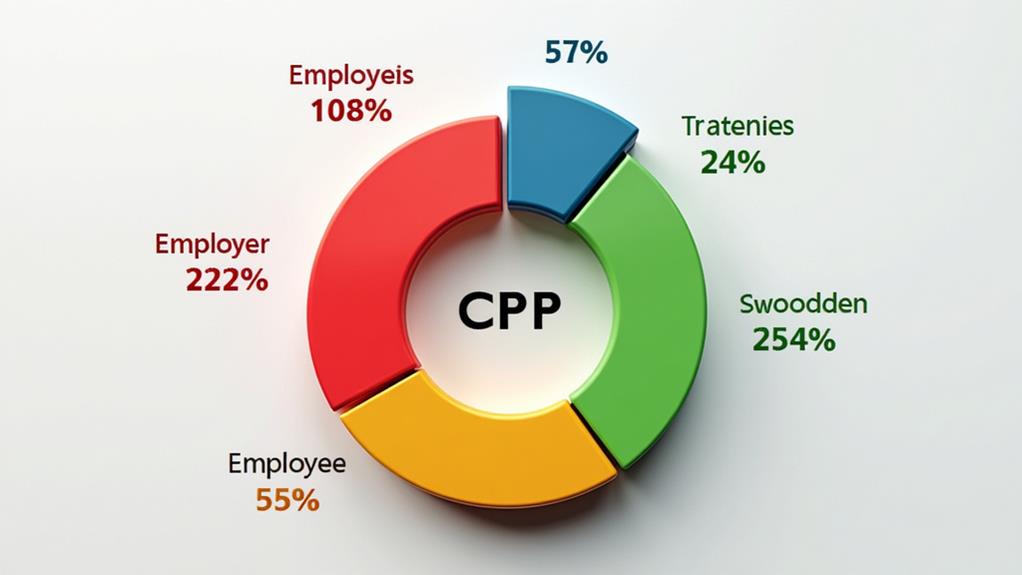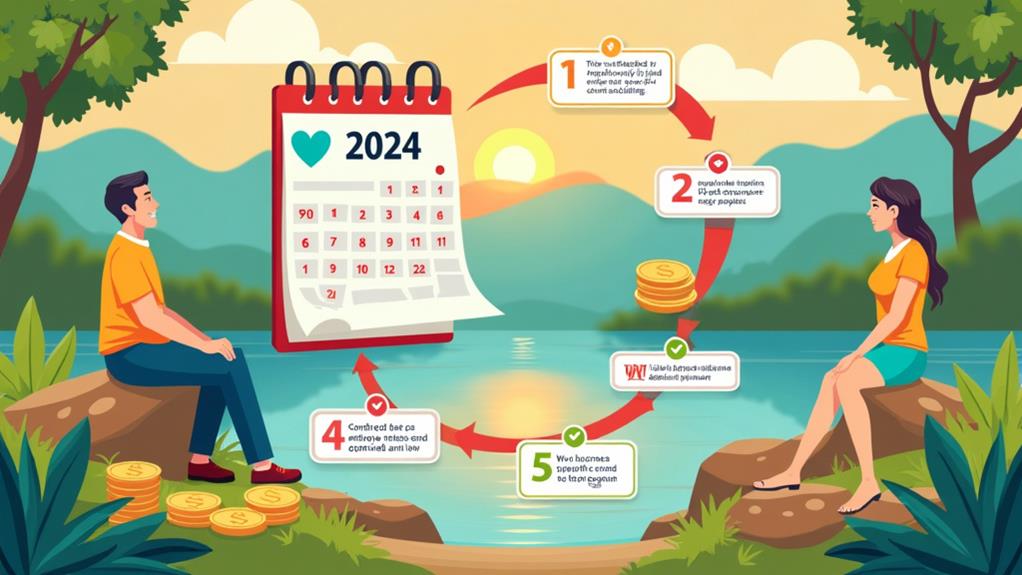The Canada Pension Plan (CPP) payment dates for 2024 typically fall on the second or third last banking day of each month, with direct deposit ensuring timely disbursements. The maximum monthly CPP payment for 2024 is projected at $1,364.60, requiring 40 years of contributions at or above the Yearly Maximum Pensionable Earnings (YMPE). Factors such as early or deferred payments, contribution rates, and supplementary benefits can notably impact retirement income. Understanding CPP eligibility, application processes, and payment calculation factors is essential for optimizing benefits and ensuring a stable income stream. Exploring the all-encompassing guide will provide valuable insights into steering through the complexities of CPP in 2024.
CPP Eligibility and Application

To receive Canada Pension Plan (CPP) payments, individuals must meet specific eligibility criteria and complete the application process. The primary eligibility requirement is that applicants must be at least 60 years old and have made at least one contribution to the CPP during their working years. This contribution history is essential in determining an individual's eligibility for benefits and the amount they will receive.
The application process for CPP benefits can be completed online through My Service Canada Account or by submitting a paper application. Online applications are typically processed within 7 to 14 days, while paper applications may take up to 120 days. When applying, individuals must provide vital documents such as a birth certificate, social insurance number, and marriage certificate if applicable.
Service Canada reviews all applications to determine eligibility status based on the information provided. Applicants can check their contribution history and eligibility through My Service Canada Account to guarantee an accurate assessment before applying for benefits.
It is important to note that while individuals can start receiving CPP payments as early as age 60, delaying benefits until age 70 can result in considerably higher monthly payments. This is because the CPP is designed to provide a larger benefit to those who wait longer to start receiving payments, as they will have made more contributions over their working years.
2024 Payment Schedule
The Canada Pension Plan (CPP) provides a reliable source of income for eligible Canadians in their retirement years. Understanding the payment schedule is vital for beneficiaries to plan their finances effectively. In 2024, CPP payments will typically be made on the second or third last banking day of each month. This consistent schedule allows recipients to anticipate when the funds will be available in their accounts.
Direct deposit is the preferred payment method for CPP benefits. By enrolling in direct deposit, beneficiaries can guarantee timely receipt of their payments directly into their bank accounts. This eliminates the need to wait for cheques to arrive in the mail and provides a secure and convenient way to access funds. Those who have not opted for direct deposit will receive their payments via mailed cheques, which may arrive later than the direct deposits.
It is important to note that in December, CPP payments are scheduled earlier to accommodate holiday banking hours. This adjustment guarantees that beneficiaries receive their funds before the holiday season, allowing them to plan accordingly. Recipients should be aware of these holiday adjustments and factor them into their financial planning.
For those expecting CPP payments in 2024, it is essential to keep track of the payment dates, especially if traveling or anticipating mail delays. By understanding the payment schedule and choosing the most suitable payment method, beneficiaries can effectively manage their finances and enjoy the benefits provided by the Canada Pension Plan.
Maximum CPP Amounts

Achieving the maximum CPP benefit requires careful planning and consistent contributions throughout one's working life. For 2024, the highest monthly CPP payment is set at $1,364.60, amounting to an annual total of $16,375.20. To qualify for this maximum amount, individuals must have contributed to the CPP for at least 40 years at or above the Yearly Maximum Pensionable Earnings (YMPE). This threshold is adjusted annually to reflect changes in the average wage index.
The average monthly CPP retirement pension as of October 2023 stands at $758.32, with projections indicating a rise to $816.52 in 2024. However, several factors can notably impact the total CPP amount received, such as periods of low earnings, child-rearing, and changes in marital status. Effective CPP payment strategies involve maximizing contributions during peak earning years and considering the benefits of contributing after age 65, as these contributions count towards post-retirement benefits (PRB).
It is essential for individuals to stay informed about maximum contribution limits and adjust their financial plans accordingly to optimize their CPP benefits. By consistently contributing at or above the YMPE and strategically timing contributions, Canadians can work towards securing a more comfortable retirement income through the CPP. Seeking professional financial advice can also help individuals navigate the complexities of the CPP system and develop personalized strategies to maximize their benefits.
Early Vs. Deferred Payments
Deciding when to start receiving CPP payments is a critical consideration for Canadians approaching retirement age. The standard age to begin receiving full CPP benefits is 65, but individuals have the flexibility to start as early as 60 or defer until age 70. Early retirement options allow for CPP payments to begin at 60, with a reduction of 0.6% per month for each month before age 65, resulting in a maximum reduction of 36%. This may be a suitable choice for those who need immediate income or have health concerns that could impact their life expectancy.
On the other hand, delaying CPP payments until age 70 results in an increase of 0.7% per month, leading to a potential maximum increase of 42% compared to starting at age 65. This strategy can greatly boost lifetime benefits for those who expect to live longer or have other sources of income in the early years of retirement.
Individuals who choose to work while receiving CPP benefits can continue to make contributions, potentially enhancing their pension amount if they delay taking their full retirement benefits. Payment strategies should be carefully considered, as the decision to take CPP early or defer can considerably affect the total amount received over a lifetime. It is essential to evaluate personal financial needs, life expectancy, and overall retirement plans when determining the ideal time to start receiving CPP payments. Consulting with a financial advisor can help individuals make an informed decision based on their unique circumstances.
Contribution Rates

How much Canadians contribute to the Canada Pension Plan (CPP) plays an imperative role in determining their future retirement benefits. In 2024, the employee and employer contribution rates for the CPP are set at 5.95%, with a maximum contribution of $3,867.50 each. Self-employed individuals face a higher contribution rate of 11.90%, with their maximum contribution increasing to $7,735.00 in 2024. For the CPP2, an additional tier of the pension plan, the contribution rates for both employees and employers are set at 4.00%, with maximum contributions of $188.00 each.
Examining contribution trends reveals that rates have been steadily increasing annually from 2018 to 2023, reflecting adjustments based on cost of living and program funding needs. These changes in contribution rates can greatly influence future pension benefits, making it vital for Canadians to take into account them when planning for retirement.
Developing effective contribution strategies is important for maximizing retirement income. Canadians should assess their current financial situation and retirement goals to determine if they should contribute more than the required amounts. Additionally, regularly reviewing and adjusting contribution levels as income and circumstances change can help guarantee a more comfortable retirement.
Understanding the CPP contribution rates and their impact on future benefits is vital for Canadians as they navigate their retirement planning journey. By staying informed about contribution trends and developing personalized contribution strategies, Canadians can take proactive steps towards securing a stable income in their golden years.
Additional CPP Benefits
Beyond the standard retirement pension, the Canada Pension Plan provides a range of additional benefits to support Canadians in various life circumstances. One such benefit is the disability pension, which offers financial assistance to individuals under the age of 65 who are unable to work due to a disability. This pension guarantees a steady income until the recipient reaches retirement age, at which point they shift to the regular retirement pension.
Another important additional benefit is the survivors pension, designed to support the spouses or partners of deceased CPP contributors. This pension helps maintain financial stability for the surviving partner, with the amount determined by the deceased's contributions to the plan.
The CPP also offers a Children's Benefit, providing monthly payments to dependent children of disabled or deceased contributors until they reach the age of 25. This benefit helps support the children's ongoing needs, such as education and living expenses.
In the event of a contributor's death, the CPP Death Benefit provides a one-time payment of up to $2,500 to cover funeral expenses for the beneficiaries. This benefit helps alleviate some of the financial burden during a difficult time.
Lastly, Post-Retirement Benefits (PRBs) are available for individuals who continue working and contributing to CPP after starting their retirement pension. These additional contributions result in increased payments, allowing retirees to further supplement their income.
These additional CPP benefits demonstrate the all-encompassing nature of the plan, guaranteeing that Canadians receive support throughout various stages of life and in different circumstances.
Payment Calculation Factors

The amount of Canada Pension Plan (CPP) benefits an individual receives is determined by a combination of factors, each playing a essential role in the calculation process. One of the most significant factors is the individual's contribution history, which spans from age 18 until retirement or age 70. The total contributions made throughout this period form the basis for the CPP payment calculation.
The age at which an individual chooses to start claiming CPP benefits also influences the payment amount. Early withdrawal, prior to age 65, results in a reduction of 0.6% per month, while delaying benefits past age 65 can lead to an increase through post-retirement benefits. These benefit adjustments are made to guarantee fairness and to account for the varying lengths of time individuals contribute to and receive benefits from the plan.
To receive the maximum monthly CPP payment, projected to be $1,364.60 in 2024, an individual must have contributed at or above the Yearly Maximum Pensionable Earnings (YMPE) for at least 40 years. However, periods of low or no salary, such as during child-rearing years or disability, can negatively impact the overall contribution history and, in turn, the CPP payment amount.
Understanding these factors is essential for individuals planning their retirement income. By considering their contribution history and the timing of their benefit claims, Canadians can make informed decisions to maximize their CPP benefits and guarantee a more stable financial future in their golden years.
Late Payment Procedures
Despite the reliability of the Canada Pension Plan (CPP) payment system, there may be instances when individuals do not receive their payments on the scheduled dates. In such cases, it is vital to follow the appropriate steps to address the issue. If your CPP payment does not arrive by the expected date, the first step is to wait for five working days before taking further action. This waiting period allows time for potential processing delays or minor discrepancies to be resolved.
However, in certain cases, a longer waiting period of 10 working days may apply before contacting the Canada Revenue Agency (CRA) for assistance with unpaid payments. During this time, it is important to keep accurate records of payment dates and any communication regarding the issue, as this information will be valuable when discussing the matter with the CRA.
If, after the appropriate waiting period, your payment remains unpaid, the next step is to contact the CRA directly to resolve the issue. When reaching out, be prepared to provide relevant details, such as your Social Insurance Number, expected payment date, and payment tracking information. The CRA will work with you to investigate the cause of the delay and take the necessary actions to guarantee you receive your CPP payment as soon as possible.
To stay informed about your CPP payments, regularly check your My Service Canada Account for updates and important information. By following these late payment procedures and maintaining clear communication records, you can effectively address any issues that may arise with your CPP payments.
International Considerations

Canadians living abroad can continue to receive their Canada Pension Plan (CPP) payments, guaranteeing a consistent income stream regardless of their country of residence. However, those who have previously received benefits, been denied benefits, or have third-party management may need to submit a paper application to guarantee uninterrupted payments.
CPP payments for international recipients typically follow the same schedule as those in Canada, with funds being disbursed on the second or third last banking day of each month. To minimize the risk of delays associated with mail delivery, recipients living abroad are strongly encouraged to register for direct deposit. This guarantees timely receipt of their payments and reduces the potential for lost or stolen checks.
It is essential for Canadians residing outside the country to stay informed about any changes to CPP payment schedules or eligibility criteria that may affect their benefits. They should regularly review official government resources and communicate with Service Canada to remain up-to-date on any developments.
When receiving CPP payments internationally, beneficiaries should be aware of the impact of currency fluctuations and international banking regulations on their funds. The final amount received in their local currency may vary depending on exchange rates at the time of payment. Additionally, local banking laws and fees may influence the accessibility and use of funds received through international transfers. Beneficiaries should consult with their financial institutions to understand any potential limitations or requirements related to receiving CPP payments abroad.
Taxation of CPP
As a significant component of retirement income for many Canadians, Canada Pension Plan (CPP) payments are subject to taxation, which can greatly impact financial planning and budgeting. CPP benefits are regarded as taxable income and are subject to the recipient's marginal tax rate when filed on their annual income tax return. Taxation of CPP begins when recipients start receiving benefits, with the amount withheld varying based on total income and personal tax situation.
To manage the tax implications of CPP income, recipients can choose to have federal and provincial taxes withheld from their monthly CPP payments. This approach helps avoid a lump sum tax payment at year-end, which can be challenging for those on fixed incomes. It's important for CPP recipients to accurately report their CPP income on their tax returns to guarantee proper tax calculations and avoid potential penalties.
Furthermore, if a recipient is also receiving Old Age Security (OAS), the combined income may affect clawbacks on OAS, impacting overall taxation. To effectively manage their financial health during retirement, it's essential for CPP recipients to take into account the tax implications of their benefits and plan accordingly. Seeking the advice of a financial advisor or tax professional can help individuals navigate the complexities of CPP taxation and make informed decisions about their retirement income.
CPP and Retirement Planning

Incorporating CPP payments into an extensive retirement plan is a key consideration for many Canadians. With the flexibility to start receiving CPP benefits between the ages of 60 and 70, individuals have the opportunity to develop CPP strategies that align with their unique financial circumstances and retirement readiness. The standard payment age for CPP is 65, but opting to receive payments earlier or later can greatly impact monthly benefit amounts. As of October 2023, the average monthly CPP retirement pension stands at $758.32, a figure that can be influenced by factors such as the age at which benefits are taken and the total contributions made throughout one's working life.
Delaying CPP payments beyond age 65 can result in a 0.7% increase in monthly benefits for each month deferred, up to a maximum of 42% if benefits are taken at age 70. This strategy can be particularly advantageous for those who continue working past the standard retirement age, as contributions made after age 65 can count towards post-retirement benefits (PRB), further enhancing retirement income. To make informed decisions about CPP and retirement planning, it is essential to understand the factors that influence CPP payments, such as contribution history and employment status. By carefully considering these elements and developing personalized CPP strategies, Canadians can optimize their retirement readiness and guarantee a more financially secure future.
CPP and Other Benefits
In addition to the retirement pension, the Canada Pension Plan (CPP) provides a range of supplementary benefits designed to support contributors and their families during times of need. These additional benefits include disability benefits for those unable to work due to disability, survivor support for the families of deceased contributors, and benefits for dependent children.
The CPP disability pension is available for individuals under 65 who are unable to work due to a severe and prolonged disability. The post-retirement disability benefit is an option for those who become disabled after starting to receive their CPP retirement pension. Dependent children of disabled or deceased contributors may also be eligible for the children's benefit.
Survivor support is another vital aspect of the CPP. The survivors pension provides ongoing financial assistance to the spouse or common-law partner of a deceased contributor, with the amount based on the contributor's CPP contributions. Additionally, a one-time CPP death benefit of up to $2,500 may be paid to help cover funeral expenses.
It is important to note that these additional benefits require separate applications and have specific eligibility criteria. Understanding the available options can help guarantee that contributors and their families receive the financial support they need during challenging times.
When planning for retirement, it is also essential to take into account the flexibility in the timing of CPP payments. Contributors can choose to start collecting their CPP retirement pension between the ages of 60 and 70, with adjustments made based on the age at which benefits commence. Early collection will result in reduced payments, while delaying benefits will lead to increased amounts.
Sharing CPP With Partner

The Canada Pension Plan offers the option for couples to share their retirement pensions, providing an opportunity for a more balanced distribution of benefits. Pension sharing allows partners to allocate their CPP benefits based on each individual's contributions, promoting contribution equity within the relationship.
To be eligible for CPP sharing, both partners must be receiving their retirement pensions. They can apply for sharing simultaneously or after one partner has already started receiving benefits. The shared amount is determined by calculating the total contributions both partners have made to the CPP throughout their working lives.
Pension sharing can be particularly advantageous when one partner has notably higher CPP contributions than the other. By redistributing the benefits, couples may increase their overall pension income and achieve a more equitable financial situation in retirement.
To apply for CPP sharing, couples must provide necessary documentation, including marriage certificates and proof of identity. Applications can be submitted online or through paper forms available from Service Canada. It is essential for couples to carefully consider their individual circumstances and seek guidance from financial advisors or Service Canada representatives to determine if pension sharing is the right choice for their unique situation.
CPP Statement of Contributions
Understanding one's contribution history to the Canada Pension Plan is essential for planning a secure retirement. The CPP Statement of Contributions is an important document that outlines an individual's contributions to the plan, detailing the amount contributed each year and the periods of contribution. Canadians can access their statement through their My Service Canada Account, allowing them to verify the accuracy of their contribution records and guarantee that all contributions are recorded correctly.
The statement plays a significant role in determining potential CPP benefits, as it reflects the contributions that influence the calculation of retirement pensions and other benefits. It includes information on the Yearly Maximum Pensionable Earnings (YMPE) and any periods of low or no contributions, which can affect the final pension amount. By reviewing the statement regularly, individuals can gain a clear understanding of their contribution history and make informed decisions regarding their retirement planning.
Verifying the accuracy of one's CPP Statement of Contributions is essential for maximizing retirement benefits. Any discrepancies or errors in the statement should be addressed promptly to avoid potential issues when claiming benefits in the future. By taking an active role in reviewing and managing their contribution records, Canadians can lay the foundation for a more secure and financially stable retirement.
Frequently Asked Questions
Will CPP Increase in 2024 for Seniors in Canada?
Yes, CPP benefits for seniors in Canada will increase by 4.8% in 2024 due to inflation adjustments. The average monthly CPP retirement pension is projected to be $816.52, up from $758.32 in 2023.
What Are the CRA Payment Dates in 2024?
CRA benefit and credit payments are typically issued on the second or third last banking day of each month in 2024. CPP eligibility and payment frequency remain unchanged, with direct deposit ensuring timely receipt.
What Is the Federal Payment in Canada in 2024?
The $300 federal payment in Canada for 2024 is a one-time financial assistance provided by the government to support low-income individuals and families facing increased living costs due to inflation and other economic factors.
What Cheques Come Out in July 2024?
In July 2024, the Canada Pension Plan (CPP) retirement pension cheques are scheduled for release on July 30, the second last banking day of the month, with an average monthly payment of $816.52.
Conclusion
To summarize, the Canada Pension Plan remains a crucial component of retirement income for eligible Canadians. The 2024 payment schedule, maximum benefit amounts, and contribution rates are essential factors to evaluate when planning for retirement. Understanding the implications of early or deferred payments, the relationship between CPP and other benefits, and the option to share CPP with a partner can help individuals make informed decisions and optimize their retirement income strategy.